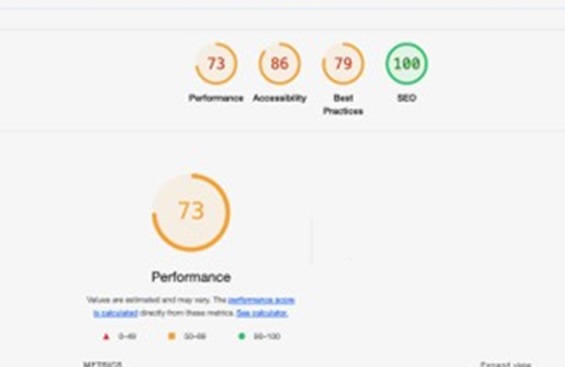And that affects SEO, which in turn impacts search rankings and whether anyone can find you.
Search engine ranking factors
Google Search engines, like Google, are constantly updating how they rank websites. They favour sites that are fast, secure, and regularly updated. If yours is not one of those, it will most likely drop in search rankings, making it harder for potential customers to find you online.
Staying in shape
Website performance impacts nearly every aspect of the success of your website. Your website needs to keep up with expectations. How quickly it loads, how easy it is to use, and how well your website works on different devices such as phones, laptops, tablets and desktops all contribute to what’s called “site performance.” Google uses site performance as a factor in how it ranks websites in search results.
Site performance matters
Regular updates help keep your site visible to people searching for your services. Faster, better-optimised sites are more likely to appear at the top of the search results,
Your website is a living project that needs ongoing care and attention
You can’t launch a website and then just forget about it. Sadly, Google won’t let you get away with it. But we can help. A Woodswork website health check will identify performance, accessibility, and SEO issues. We can then make updates and improvements to enhance user experience, boost search engine rankings, and make your business website faster, more accessible, and more effective.
How we can help
We’ll run a detailed website performance check. We’ll look at four key areas:
- Performance: People expect sites to be fast and easy to navigate. If your website is slow, visitors may leave before it fully loads. We’ll check how fast your website loads on all devices, how long it takes for the first content to appear on the screen and how long it takes for the site to be fully interactive.
- Accessibility: How easy is your site to use for people with disabilities? Have you included alternative text for images? Is your content easy to read? Is there sufficient contrast between text and background colours?
- Best Practices: We’ll check to see if your site has any security risks or outdated technologies that could cause problems. Fixing these will make your site safer and run more smoothly.
- SEO (Search Engine Optimisation): Is your site is easy for search engines like Google to understand? We’ll look at things like whether your pages have descriptive titles and meta descriptions.
Covering the gaps
BMH is recognised as the industry leader in spa and pool covers for Kiwi pool owners. We looked at their website and carried out a website performance check. The report gave us clear, actionable insights and we made the necessary adjustments to ensure their online presence is as strong as possible. Just look at the improvements we made. The before and after screenshots focus on website performance.

A Woodswork health check
We didn’t think it proper to use the report on BMH Pool Covers here. However, to demonstrate how we helped them, I have made up a report for an imaginary Auckland construction company called BuildItGood using the same tools.
The BuildItGood website looked professional, but it wasn’t performing well, and the report was not good. Below is a summary of the specific actions we could take to improve that site’s performance. Some of these are similar to the type of help we provided for BMH Pool Covers.
BuildItGood website performance report
- Performance: 45/100
- First Contentful Paint (FCP): 5.2 seconds (slow)
- Largest Contentful Paint (LCP): 6.8 seconds (slow)
- Total Blocking Time (TBT): 1.2 seconds (high)
- Cumulative Layout Shift (CLS): 0.35 (poor)
- Accessibility: 65/100
Issues: Low contrast text, missing alt text on images, some buttons are too small to tap easily on mobile.
Best Practices: 70/100
Issues: Outdated JavaScript libraries, some insecure connections.
SEO: 60/100
Issues: Missing meta descriptions, no HTTPS, critical content is hidden, duplicate content.
The first thing to note: this is not a good report. Let’s look at three common issues that have arisen in our website performance check, what they mean and how we can fix them.
Fixing 3 common website issues
Issue: Slow First Contentful Paint (FCP) and Largest Contentful Paint (LCP).
This means that large images are taking too long to load, and some scripts are blocking the page from becoming interactive. Multiple high-resolution images in a slider increases the time it takes for the first and largest pieces of content to appear, causing delays.
How to fix:
We’ll look at exactly which parts of your site are slowing it down. For example, it might be that certain images are too large or that your site is loading too many scripts (pieces of code) that aren’t necessary. We would optimise all large images(e.g., high-resolution photos of completed construction projects) by converting them to the WebP format which will reduce load times. For example, a 500KB JPEG image could be reduced to 150KB with WebP.
We would replace the slider with a single, high-quality static image or a hero section that clearly communicates the key message. While sliders can be visually appealing, their impact on performance, user experience, and SEO is usually negative.
Some images aren’t immediately visible when the page loads because they are below the fold line i.e., they only load when the user scrolls down the page. We would implement ‘lazy loading‘ to speed up the initial page load.
Issue: Low contrast text and missing alt text on images.
This means the text is hard to read because it is sitting over the top of an image or there is not enough contrast between text and background.
How to fix:
Adjusting the colour scheme would improve text readability. For example, if the current text is light grey on a white background, we would switch to a darker grey or black.
Text over images negatively affects contrast and readability, leading to poor user experience.
We would review all images and add descriptive alt text.
Issue: Missing meta descriptions, hidden and duplicate content
This requires an SEO fix. Meta descriptions are brief summaries that sit in the backend of web pages. They appear in search results and help to attract clicks – they affect the CTR. For example, 5 different pages might have a description like: “BuildItGood – Quality Construction Services in Auckland. Contact us for residential, commercial, and industrial building projects. We do new builds and renovations”
How to fix:
All pages need unique meta descriptions; Google does not like duplicate content. They also need to be of a certain length. The example above is too long. We would create unique, descriptive, keyword-rich meta descriptions for all important pages on the site that fit Google’s parameters.
Critical content is also hidden behind the slider, which means that unless users or search engines interact with it, they may not see it. We would shift key content outside the slider so the information is available without users having to click and wait while it loads. This will improve both user experience and SEO.
Regularly updating your website keeps your site secure, fast, and user-friendly. Maintaining your website helps keep your online presence strong so more people will find your business when searching.
Better performance, better results
There’s little point in having a website if no one can find it or it frustrates your users, and they quickly leave. Improving your website’s performance your bounce rate (how often people come to your site and leave immediately), visitor duration and signals to Google that you care about visitor experiences. Over time, Google will recognise your efforts and reward you with better rankings.
If you’d like to have a professional analyse and diagnose your website performance issues? Then get in touch and we can perform a full website performance check and work on solving any issues we find.
Woodswork Web is here to build and support smart, engaging websites that help businesses grow through high-quality traffic and website engagement.
Get your site moving
I wrote this case study and the web copy for Woods Work Web.
This case study is an example of how other Clare Woods and I have helped our clients manage their growing businesses.
If you would like help getting your business moving, please reach out.

